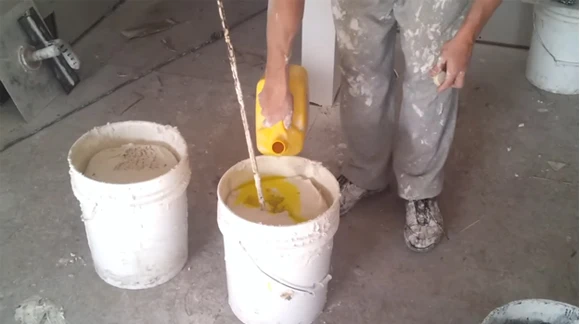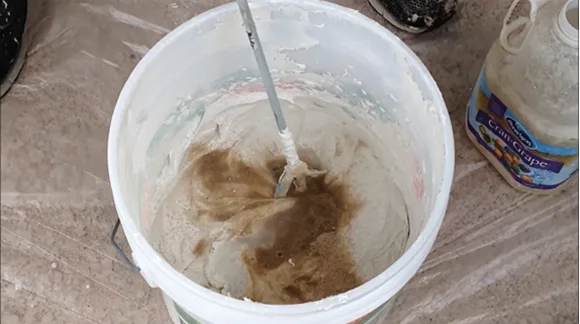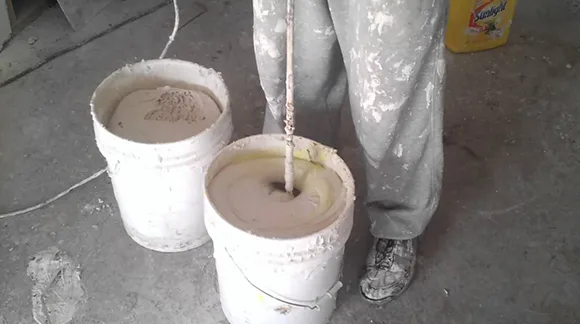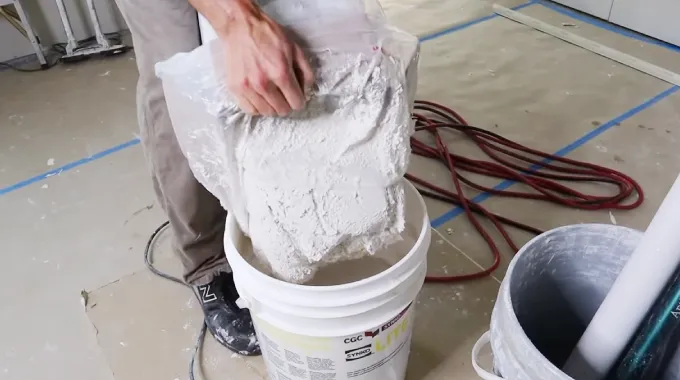Last Updated on January 31, 2023
Are you considering sprucing up your home and wondering if you can mix drywall mud and paint to create a unique effect? Of course! Mixing drywall mud with paint is the key to transforming your walls into vibrant works of art. Not only will it add texture, but you’ll be able to unleash your creativity simultaneously.
Give your boring walls an instant facelift with a mix of drywall mud and paint. This wallet-friendly DIY project is easy to do, so you can give those blank surfaces an eye-catching look they deserve.
Let’s examine how to mix these compounds, what paints to avoid, and why bubbling might occur.
How Can You Mix Drywall Mud With Paint?

Mixing drywall mud with paint is a unique, textured finish that can be used on walls, ceilings, and other surfaces. Following these simple steps, you can easily mix drywall joint mud and paint:
Step 1: Gather Your Supplies
You will need the following supplies:
- Joint drywall compound,
- A bucket,
- Stirring stick or Stirrer,
- Roller or brush,
- The paint of your choice.
Step 2: Prepare Joint Compound
Once you have gathered all your supplies, it is time to prepare the joint compound. Start by measuring the amount of powder joint compound you need for your project and add it to the container.
Next, add an appropriate amount of water and stir until it forms a thick paste-like consistency. It should be spreadable but not too runny. If needed, adjust the consistency by adding small amounts of either joint compound or water until it reaches the desired level of thickness.
Step 3: Add Paint to the Compound
When your joint compound mixture has reached its desired consistency, you can add small amounts of paint to ensure everything is mixed correctly. Measure out an equal quantity of paint to what was used for the joint compound and pour it into the container.
Only add a little paint at a time, as this will cause it to become too thin or lumpy. Use a handheld electric mud & paint stirrer to stir up the mixture after each added drop of paint until it has been fully incorporated into the paste before moving on to the next step. The compound’s color should be uniform throughout, with no streaks or discoloration.
Step 4: Roll & Apply
Now that your drywall mud mixture is ready, you can begin rolling and applying it to whatever surface you try to cover. Use a unique roller designed for this purpose or a regular roller slightly dampened beforehand for smoother application.
Work in small areas first and ensure that each section is appropriately covered before moving on to another part of the wall or ceiling. The goal here is even coverage over all surfaces without any visible gaps between applications.
Step 5: Clean Up & Finish
Once all surfaces have been sufficiently covered with your drywall mud and paint mixture, let everything sit for about 2-4 hours before starting with any cleanup work or finishing touches.
When finished, take some wet paper towels and lightly wipe off any excess dust from the walls or ceilings to give them an even cleaner look once everything is dried up entirely overnight.
What are the Benefits of Mixing Drywall Mud With Paint?

Mixing drywall mud with paint can be a great way to add texture and character to your walls. With the right combination of paint and drywall mud, you can create attractive designs with a unique look and feel. Here are some of the top advantages of combining drywall mud with paint:
1. Improve Coverage and Durability: Mixing drywall mud with paint can improve coverage and durability, making it ideal for high-traffic home areas. The combination can help create a smoother finish and provide a more uniform appearance to the finished surface.
2. Create Unique Color Combos: With drywall mud mixed with paint, homeowners can combine colors they wouldn’t usually be able to get from prefabricated colors. This makes it easy to add an extra punch of color or an interesting contrast to a wall or ceiling.
3. Easier Application: The combination of drywall mud and paint means you don’t have to spend as much time painting. Because the mixture is thicker than regular paint, it will spread more quickly and evenly across surfaces, leading to better coverage in fewer coats.
4. Cost Savings: Unlike regular paints, mixing drywall mud with paint eliminates the need for primer. The mixture does its job in one go. It also improves the adhesion strength of the paint, meaning the walls are less likely to need repainting in future years.
5. Eco-Friendly Option: Another great benefit of using this mix is that it’s kinder to the environment. While conventional paints often contain volatile organic compounds (VOCs), which could harm air quality, most drywall mixtures do not contain VOCs, making them safer for people and pets.
6. Improved Fire Resistance: An ideal use for this mixture is in a garage or workshop. Adding drywall mud to your paint mixture can increase fire resistance due to its higher insulation properties, giving you added peace of mind when working with tools that might cause sparks!
7. Customizable Texture: Drywall Mud used in conjunction with your typical latex-based paint gives you control over the texture. By varying the amount used per gallon of paint, you can give your walls a unique feel, from smooth & glossy to rough & textured.
8. Increased Adhesion Strength: When applied correctly, mixing drywall mud with paint adds an extra layer between your wall and whatever else may come into contact with it, resulting in greater adhesion strength overall. This means less chipping & peeling, so your walls look perfect for long periods.
9. Hides Imperfections: It’s easy for small cracks or blemishes to show up on your walls over time due to wear and tear from everyday life or natural settling within the structure of a building itself.
With drywall mud and paint, any imperfections are easily camouflaged for a seamless look. Plus, having this uniform finish gives your home an extra touch of appeal that will surely attract potential buyers should you decide to sell in the future.
Is it Safe to Mix Drywall Mud With Paint?

Yes, it is safe to mix drywall mud with paint. When drywall mud and paint are mixed, the product provides strength and durability while creating a smooth finish. The combination creates a much more powerful sealant than either one of the two components would separately.
Also, mixing the two helps protect against moisture seepage and protects walls from potential water damage. But, it is essential to note that you should not mix oil paint with drywall mud as they do not mix properly.
How Long Does the Drywall Mud and Paint Mixture Have to Cure?
Once the drywall compound mud and paint combination has been applied to a surface, it needs at least 24 hours to cure before proceeding.
During this period, the paint will absorb into the wall’s surface and create an even stronger bond that helps protect against water damage or other deterioration. Once the mixture has fully cured, you can add other desired finishes like wallpaper, tiles, or textured finishes.
What Paint Should You Not Mix With Drywall Mud?
You should not mix oil-based paints with drywall mud because they won’t mix well. Oil-based paints require special preparation for application onto walls and, when mixed with drywall mud, can cause inconsistent results on the finished surface.
Also, oil-based paints cannot be applied over fresh drywall mud as this may cause bubbling due to trapped air bubbles underneath the coating, which could lead to cracking or peeling of the finish. So, always use water-based paints when mixing with drywall mud to get desirable results from your project.
Why Does Drywall Mud Bubble When Mixed With Paint?

Drywall mud bubbles when mixed with paint because air has become trapped within the layers of material during the application, and there is no way for it to escape without disrupting the appearance of the coating’s texture or integrity.
Applying a fresh coat of paint over an existing layer seems like it should be a straightforward fix for air bubbles, but the reality isn’t that simple. Different drying times or temperatures between coats can mean your effort might backfire, resulting in bigger bubbling problems.
This problem can be avoided by ensuring proper ventilation while curing periods are observed between layers and carefully inspecting each coat before applying another layer of material.
Topics of Interest: Can a paint sprayer use more paint than a roller?
Customize Your Drywall – Mix Drywall Mud With Paint
Transform your home or office into something special with an incredibly affordable secret weapon: a mix of drywall mud, and paint.
Not only will it create thicker, more durable, and long-lasting walls than regular paint alone, but you’ll also be able to customize their look. It’s the perfect way to make any space remarkable.
Still, you shouldn’t mix certain types of paint with drywall mud. So steer clear of those particular paints when working with wall mud. Remember to give your project plenty of time for curing before wrapping things up.
Recommended Article To Read:



